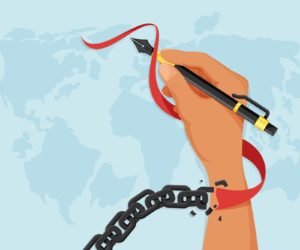By David Laitphlang
 Each year, ‘World Press Freedom Day’ reminds us that the freedom to inform, to question, and to challenge power remains a cornerstone of any vibrant democracy. In 2025, the theme — ‘A Press for the Planet: Journalism in the Face of the Environmental Crisis’ — resonates deeply in Meghalaya, a state where journalists are both witnesses to nature’s majesty and chroniclers of its exploitation.
Each year, ‘World Press Freedom Day’ reminds us that the freedom to inform, to question, and to challenge power remains a cornerstone of any vibrant democracy. In 2025, the theme — ‘A Press for the Planet: Journalism in the Face of the Environmental Crisis’ — resonates deeply in Meghalaya, a state where journalists are both witnesses to nature’s majesty and chroniclers of its exploitation.
Here, in the heart of India’s North East, the press plays a vital role not only in defending democracy, but in safeguarding the environment. And yet, journalists often operate under immense pressure, from both visible and invisible forces that seek to silence their voices.
Over the years, reporters in Meghalaya have faced legal intimidation, online harassment, and physical threats for pursuing stories that speak truth to power.
 From contempt notices issued to editors for critical commentary on institutional practices, to FIRs lodged for social media posts challenging mob violence, the message has often been clear: toe the line, or face consequences.
From contempt notices issued to editors for critical commentary on institutional practices, to FIRs lodged for social media posts challenging mob violence, the message has often been clear: toe the line, or face consequences.
Journalists covering illegal land deals, coal mining routes, timber felling, and environmental violations have received veiled threats. Some have been assaulted on assignment. Others have been asked to “tone down” their reports, especially when they concern powerful interests or sensitive tribal lands. These are not isolated incidents. They are a pattern—a quiet erosion of press freedom, one case at a time.
Newer threats come not only from traditional power structures, but through ambiguous policies and digital oversight. Recent state-level communication policies have proposed regulations for “public communicators” online—raising alarm among civil society and independent journalists who fear arbitrary censorship. Critics argue that such frameworks, without safeguards, could criminalise criticism and restrict community storytelling on social media platforms.
Political actors, too, have at times turned their ire toward the press, accusing media houses of bias or misrepresentation. Such rhetoric, even if rhetorical, fuels hostility toward reporters and erodes public trust in journalism.
But even amid pressure, the press in Meghalaya continues to thrive in its most essential form: as a voice for the voiceless, and as a shield for the state’s fragile ecology.
Whether it is exposing the continuation of banned mining practices, highlighting ecological degradation in sacred groves, or documenting the plastic crisis in tourist destinations—the local media remains the first to ring the alarm bells.
Community reporters and digital storytellers have covered protests against deforestation, tracked river pollution, and brought attention to waste mismanagement in remote areas. In some cases, their reporting has led to direct policy interventions or public mobilisation for environmental protection.
Journalism here does not operate from high-rise offices—it walks on dusty roads, sits in community meetings, and records oral histories that would otherwise be forgotten.
In a welcome gesture, the state has announced financial support schemes for working journalists—especially to assist in health and emergency cases. There is also talk of creating a formal channel of coordination between the press and government departments.
Yet, these measures, while positive in intent, remain inaccessible to many independent journalists and freelancers. Legal support, physical protection during high-risk assignments, and mental health care continue to be gaping voids in the state’s support structure.
In Meghalaya, journalism is not always glamorous or profitable. It often comes at personal cost. But those who choose this path know what is at stake. Believe me I’ve travelled that road.
They continue because someone must speak for the rivers choking on sludge. For the farmers displaced by mining. For communities whose forests are being felled. For young people demanding transparency. For democracy itself.
Student journalists, digital content creators, and local reporters in Khasi, Garo, Pnar, and English are redefining what journalism looks like. With little more than mobile phones, they are building networks of resistance and awareness across the hills.
To mark World Press Freedom Day in Meghalaya is to honour those who work in silence, far from national headlines, under circumstances that often do not offer safety or recognition.
The hills do not echo like megaphones, but they remember. And so do the people.
Let this be a reminder: a free press is not a luxury in a democracy—it is a necessity. Especially in places where nature is sacred, land is identity, and silence is too often demanded in the face of injustice.
When the pen stumbles, the people suffer. But as long as even one reporter chooses to write, the truth will find its way through the mist.
(The author is a journalist, writer and former President of Shillong Press Club)



